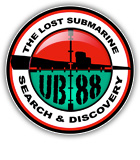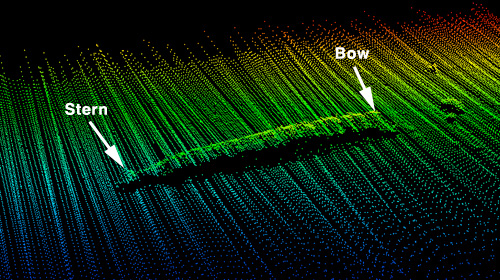
3D point cloud of ex-USS MORAY (SS-300). The image shows MORAY resting on her starboard side on a gradual slope at San Clemente Island, CA. Maximum depth at the stern is 200 ft. Data from 2002 multibeam sonar survey conducted by USNS JOHN MCDONNELL. Multibeam sonar data provided by the US Navy. Image rendered by Gary Fabian. Larger version
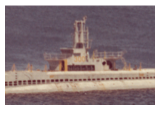 |
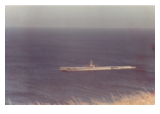 |
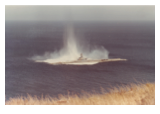 |
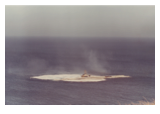 |
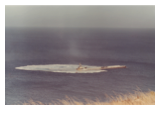 |
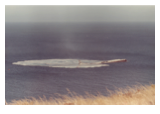 |
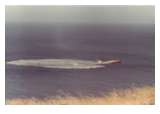 |
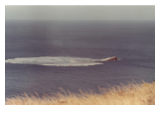 |
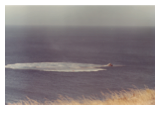 |
Image sequence of USS
MORAY's final moments captured from San Clemente Island.
U.S. Navy photographs provided by Steve Lawson.
Dive Report
ex-USS MORAY (SS-300)
San Clemente Island, CA
August 25-26, 2012
by Kendall Raine
GoPro Video and Still Frames by
John Walker and Scott Brooks
Sometimes finding the wreck
is the easy part. Getting to dive it is a whole lot
tougher. “So near and yet so far” best
describes this expedition to explore and document the
wreck of the Balao Class Fleet Type submarine USS MORAY
(SS-300) at San Clemente Island, CA.
Launched in 1944, MORAY served briefly in the Pacific
until the end of WWII earning herself one battle star.
She was decommissioned on 12 April 1946 and laid up at
Mare Island Navy Yard, Vallejo, CA. A board of inspection
and survey found her unfit for further naval service and
she was struck from the Naval Register on 1 April 1967.
MORAY was later turned over to the Naval Undersea Warfare
Center for weapon evaluations. On 18 June 1970 MORAY was
sunk at San Clemente Island during testing of the MK 103
MOD 1 torpedo warhead. She is the only known Balao Class
submarine in diveable depths on the West Coast of the
United States.
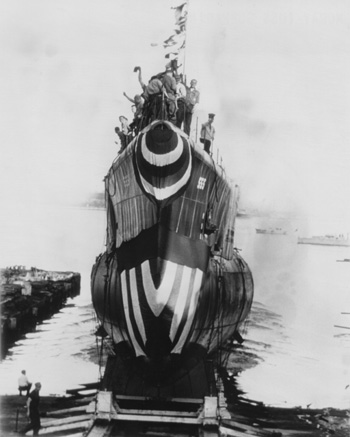
PHILADELPHIA, MAY 15 -- DOWN
THE WAYS -- THE USS MORAY, one of two submarines launched
yesterday at the Cramp Shipbuilding Company's yards here,
slides down the ways after being christened by Mrs.
Styles Bridges, wife of the Senator from New Hampshire.
(AP WIREPHOTO) 1944. Larger version
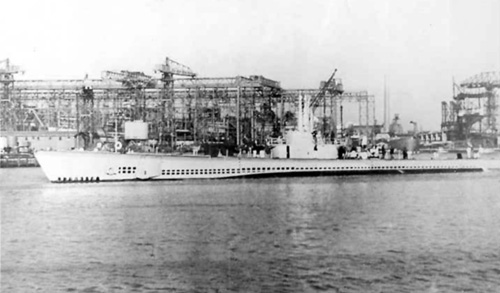
USS MORAY (SS-300) circa 1944. Image courtesy of John
Hummel via navsource.org.
Today USS MORAY lies within a permanently restricted area
of the Navy-owned island known as the Wilson Cove Safety
Zone. Gaining access to Wilson Cove required Gary Fabian
to work closely with a broad array of Naval officers from
San Diego to Washington. These discussions eventually led
Naval History and Heritage Command to act as our sponsor
for operations within the restricted area. After
submitting the necessary paperwork to NHHC we were
granted a two-day archaeological research permit to
conduct a photographic survey of the wreck site. The Navy
placed us on the SCI operations schedule for August
25-26.
Our dive team consisted of myself, John Walker, Steve
Lawson, Fred Colburn and Scott Brooks. Steve's boat, DEEP
SIX, would act as our dive platform for the operation.
Conditions that weekend were ideal as we cruised at 20
knots to San Clemente. Once we gained clearance to enter
the safety zone, we dropped a ball near the wreck and
marveled at our luck-sunshine, little wind, no swell and
hardly any current in blue water. John, Fred and Scott
geared up in anticipation of good viz and lots of light.
Our plan was to live boat and dive consecutively in two
teams.
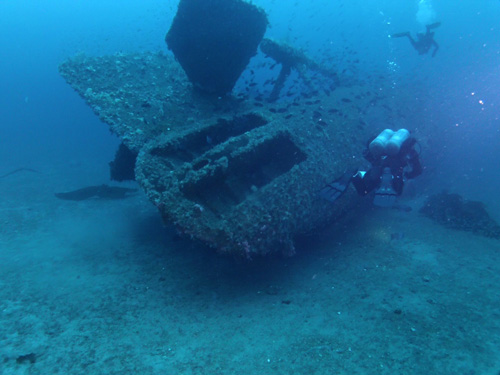
Fred Colburn and Scott Brooks examine MORAY's stern
section. Photo by John Walker.
Visibility opened up as we dropped through the
thermocline at 40 feet. Ambient light was spectacular and
the bottom composition was white sand. MORAY’s
upturned hull came into view at 120 feet. MORAY lay on
her starboard side in a north south orientation, just as
multibeam sonar imagery suggested. Steve and I dropped
onto the stern of the sub at 200 feet. We could
immediately make out the rudder, aft diving planes and
the two propeller shaft housings. Unfortunately, the
screws were missing. As we swam forward along the seaward
(top) side of the wreck, we could see where much of the
decking and outer hull had disintegrated allowing a view
to the pressure hull. At various spots we could see
though the outer hull all the way to the other side of
the sub as the outer hull frame kept the pressure hull
off the sand. This deterioration also creates thousands
of hiding places for the profusion of fish life that
inhabits the wreck site.
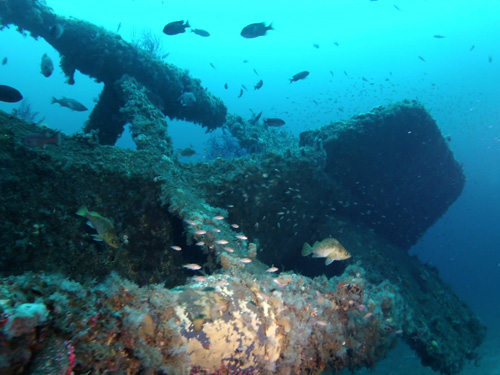
Abundant fish life attracted to MORAY. Photo by John
Walker.
The MORAY is a thriving artificial reef. Off limits to
fishermen and divers, the wreck is an untouched corner of
the marine world exploding with life and devoid of trash,
fishing lures and other detritus. Giant sheephead, ling
cod, rock fish, salmon grouper, walleye surfperch and
blacksmith are everywhere. The sea floor is littered with
large lobster molts. We even had company from sea lions
on the bottom. The invertebrate life is equally
impressive and diverse-what you’d expect from a
healthy vertical ecosystem.
As we swam forward we came over the conning tower
structure which lies in the sand on the seaward side of
the wreck. The 40 mm anti-aircraft gun and twin 50 cal
machine guns have been removed, as has the 5 inch aft
facing deck cannon. The conning tower is otherwise
completely intact-its position serving to keep the hull
from rolling down slope into deeper water. As I swam over
the periscope wells I noticed a buoyancy flask in the
sand to seaward.
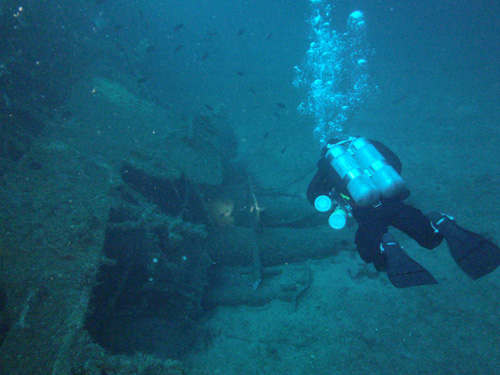
Kendall Raine over the conning tower of MORAY. Photo by
Steve Lawson.
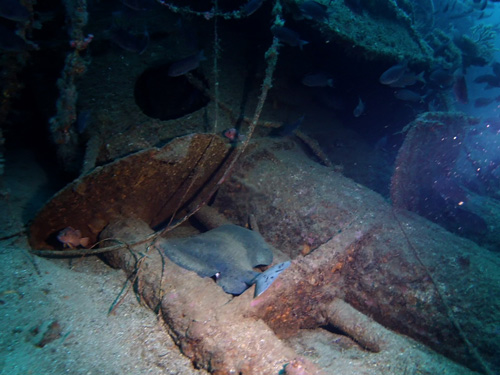
Pacific Torpedo Ray. Photo by John Walker.
Resting atop the radar mast
was a Pacific Torpedo Ray. Further forward of the conning
tower I stopped to peer inside the escape trunk. The
pressure hull hatch was open allowing a glimpse inside
the forward torpedo room.
Steve and I rounded the bow, inspected an open torpedo
tube and headed back to the stern along the underside of
the hull. At midships we came across a very large blast
area which extended well up the port side of the wreck.
The nature of the hole suggests that the MK 103 detonated
underneath the hull producing an upward pressure wave
which ripped open both the outer and pressure hulls
exposing the Pump Room and Control Room to the sea.
Damage is massive here and the sub must have sunk within
minutes. The hole is large enough to permit entry into
the Control Room. Entry into the submarine was not
stipulated on our permit, so after peering inside for a
while we continued our swim aft. We spent the last five
minutes of our bottom time further inspecting the aft
torpedo tubes.
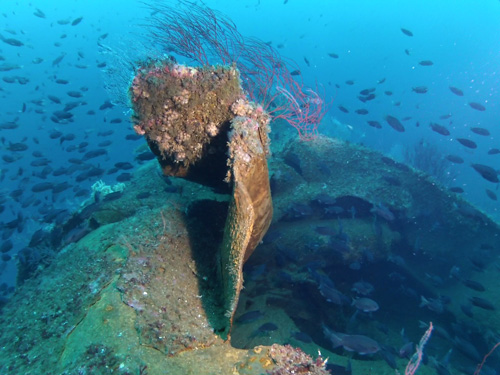
Major damage to MORAY inflicted by a MK 103 torpedo
warhead. Photo by John Walker.
The current picked up as we made our ascent.
Nevertheless, the hang was comfortable as we cleared the
50 foot stop and rose above the thermocline into 70
degree water.
We spent the night in Avalon and reviewed the video over
dinner at El Galleon. On Sunday we headed back to Wilson
Cove and repeated Saturday’s dive. Visibility and
conditions remained optimal. Our second dive allowed us
to fill in holes in our video record as well as get a
better look at the interior of the control room.
MORAY is a spectacular wreck and a real treat to dive.
The time and effort necessary to gain sponsorship just
made the reality that much more satisfying. Once again,
without the persistence and dedication of Gary Fabian,
this would not have been possible and the UB88 team is
grateful for his efforts and those of everyone who helped
us make this a reality. A special thanks goes out to Phil
Bergeron who made our lives considerably easier by
ferrying extra tanks to Avalon for the weekend.
War Record
MORAY sank two vessels during her service in the Navy.
The first vessel was the American coal barge ANNAPOLIS,
sunk off Rhode Island in February 1945 when MORAY, on
shakedown maneuvers, accidentally rammed the anchored
barge. Fortunately, MORAY was able to rescue all three
persons aboard before ANNAPOLIS sank. Details of the
accident were entered in the war diary of MORAY's escort
ship USS GEORGE W. INGRAM (DE-62). Commander
Frank L. Barrows would later make light of the
collision in MORAY's war diary when he said "not the
first new construction boat to get tonnage during
training period, but the highest tonnage."
Despite inauspicious beginnings, MORAY arrived in Saipan
in late June 1945 and began her first and only war patrol
in Japanese home waters in July. On July 10, 1945 MORAY
torpedoed and sank a Japanese whaling vessel. She was
decommissioned April 1946 and mothballed at Mare Island
until her designation as a target vessel.
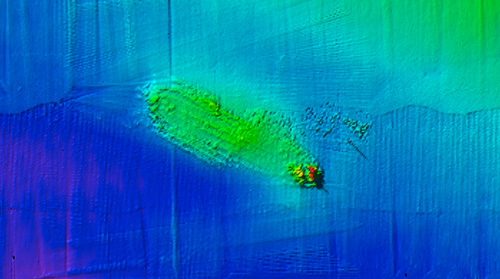
Multibeam sonar image of MORAY's first victim. American
coal barge ANNAPOLIS (aka the Black Diamond wreck) was
accidentally rammed by MORAY on 17 February 1945 off
Rhode Island. Multibeam data courtesy of NOAA. Image
rendered by Gary Fabian. Larger version
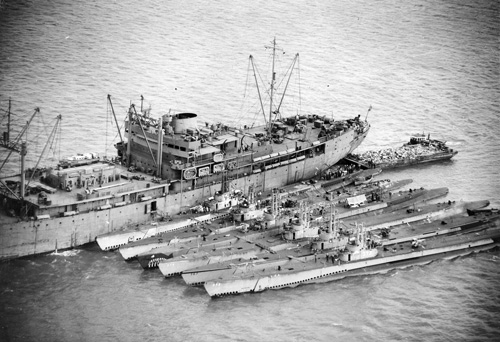
Photo dated 13 December 1945, shows the sub tender
GRIFFIN (AS-13) with six submarines alongside. The
submarines are (from the tender out) PIRANHA, MORAY,
BAYA, LOGGERHEAD, ICEFISH and LIZARDFISH. Photo courtesy
of Larry Cote and Joe Lewis. Larger version
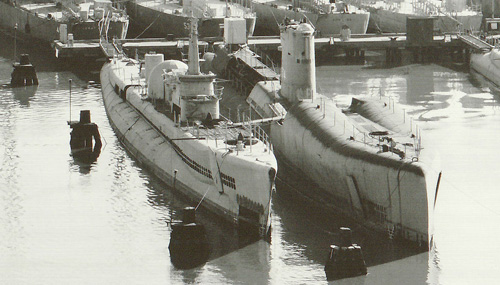
MORAY (left) in mothballs at Mare Island in 1966. SS-574
GRAYBACK is alongside. MORAY is still sporting her 5-inch
deck gun. Photo courtesy of Larry Cote and Joe Lewis.
Acknowledgements
Worthy accomplishments are
rarely achieved without the help and cooperation of other
people. This is certainly the case with USS MORAY.
Sponsorship by the Navy wouldn’t have been possible
without the help, goodwill, persistence and
professionalism of some well connected friends, numerous
officers at Naval Base Coronado, NALF San Clemente
Island, Southern California Offshore Range (SCORE), the
Secretary of the Navy’s office and the Underwater
Archaeology Branch of Naval History and Heritage Command.
We gratefully acknowledge the following individuals for
their assistance and support on this project.
(in alphabetical order)
CDR Jeffrey Barta, Chief of Staff, Naval History and
Heritage Command (NHHC)
Phil Bergeron, Diver
Alexis Catsambis Ph.D., Archaeologist & Cultural
Resource Manager, NHHC
Larry Cote, Photographer and Naval Historian
Angelic Dolan, Public Affairs Officer, Naval Base
Coronado
LCDR Eric Gatley, NALF San Clemente Island
CDR Walter Glenn, Officer in Charge, NALF San Clemente
Island
CAPT Yancy Lindsey, Chief of Staff, Navy Region Southwest
CAPT Gary Mayes, Commanding Officer, Naval Base Coronado
Dave McComb, Destroyerhistory.org
Robert Neyland Ph.D., Head, Underwater Archaeology
Branch, NHHC
VADM John Nyquist, USN (retired)
George Schwarz, Archaeologist/Conservator, NHHC
Les Stone, Southern California Offshore Range (SCORE)
Robert Tahimic, Southern California Offshore Range
(SCORE)
Diving San Clemente Island
San Clemente Island has
belonged to the US Navy since 1934. Today the island and
surrounding waters serve as an active training facility
for SEALs, Naval aviation and the surface and submarine
fleets. It remains the Navy’s only ship to shore
live fire facility. Public access is allowed only in
designated safety zones when the Navy is not conducting
operations. A schedule of the the safety zones can be
found at the San Clemente Island website. The Wilson
Cove Safety Zone is one of two zones permanently
closed to the public. There is no entry without
explicit authorization. Entering this zone without
authorization from the Navy is a Class D felony
involving the potential for jail time and fines. SCI
security actively enforces this zone, as one local
dive charter boat apparently found out when they tried
to “sneak dive” MORAY last year.
For further information please refer to scisland.org.
Sunken Military Craft
Please be advised that the disturbance of sunken military craft is prohibited. In cases where individuals or groups are interested in archaeological, historical, or educational endeavors that would result in intrusive research or the disturbance of sunken military craft, a NHHC permitting program is in place to address such requests. For further information please contact Naval History and Heritage Command.
